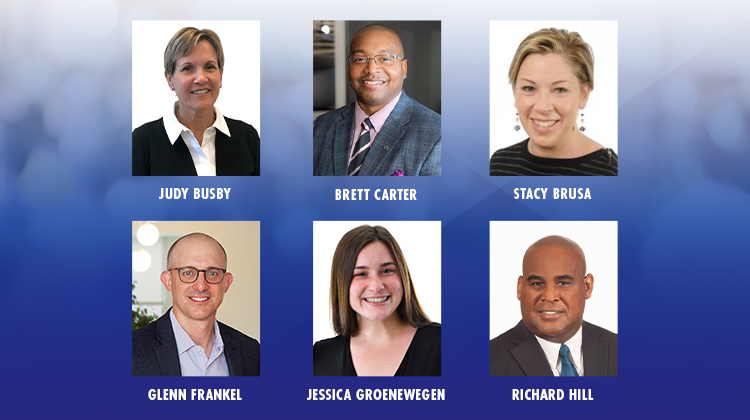The Jacobson Group’s Judy Busby, Senior Vice President, and Brett Carter, Managing Director, hosted this insightful session. They addressed the current state of the insurance industry’s labor market and the multi-generational makeup of its workforce. The presentation was followed by a panel discussion moderated by Judy Busby, featuring a multi-generational panel of professionals. The panelists included Stacy Brusa of HSB, Glenn Frankel of Gen Re, Jessica Groenewegen of TigerRisk and Richard Hill of Munich Re America, who shared insights into their generations and discussed how they have been adapting to the work from home environment.
Up first, Brett Carter spoke about the trends and shifts in the insurance industry and the disruptors affecting its workforce. While there is high unemployment in the U.S. economy overall, unemployment within the insurance industry has remained relatively low. Obviously, one of today’s major disruptors is COVID-19. Unemployment in insurance was around 1% to 2% pre-COVID, and at the time of the presentation, was 4.2%. Low unemployment ramps up competition for talent, which leads to an evolution in hiring plans.
Currently, 83% of insurers plan to increase or maintain their staff sizes in the next year, with technology, analytics, underwriting and claims roles seeing the highest demand. However, many recruiting challenges exist, including an aging workforce and competition for high-demand future skill sets, particularly data analytics. Attracting and retaining high performers from all generations is increasingly important and provides an opportunity to leverage the unique attributes and skill sets each generation has to offer. To do this, insurers have to create a positive remote culture that engages and inspires a multi-generational workforce.
Not surprisingly, the general consensus is that the insurance industry is not going to resume a “business as usual” office workplace in 2021. Companies are rethinking how we work, engage, track productivity and build community. Even as employees return to the office, approximately 77% of insurers plan to offer partial work from home options, 53% plan to provide flexible work hours and 48% plan to offer full-time remote work. Adapting to new ways of working post-pandemic is a challenge that will be best handled by recognizing the traits, beliefs, and life experiences that mark each generation and influence how they work, communicate and respond to change.
Judy Busby addressed and defined the five categories of workers currently in the workforce today: Gen Zers (age 23 and under), Millennials (24-39), Gen Xers (40-55), Baby Boomers (56-74) and Traditionalists (75-92). Millennials and Gen Xers make up the majority of the workforce, representing about 40% and 33%, respectively. Gen Zers make up about 10% of the workforce, while Baby Boomers represent roughly 15% and Traditionalists 2%.
Each of these generations carries preconceived notions and generalizations. The characteristics commonly associated with each group were discussed. Millennials, for example, are often viewed as competitive, civic-minded, open-minded and achievement-oriented. Gen Xers are thought of as flexible, informal, skeptical, independent and honest, whereas Baby Boomers are commonly seen as team-oriented, optimistic and competitive, with a strong work ethic and an aversion to change.
The discussion that followed was a series of questions for the panelists, to gain perspective on their career and work environment priorities. The answers provided by Jessica Groenewegen, a Millennial; Glenn Frankel, a Gen Xer; and Richard Hill, a Baby Boomer, were often remarkably similar. In response to what energizes you at work, Jessica highlighted the satisfaction of deal closing, whereas Glenn spoke about the importance of working with good people and solving complex issues. On the topic of remote working challenges, chief among the factors was the lack of face-to-face interactions with colleagues and clients. On the other hand, all of the panel participants recounted how they enjoyed the lack of a commute and the benefits of more family time and free time to strike a greater work-life balance. To bridge the social disconnect, the panel reported that their organizations and teams were more mindful of planning social interactions, such as virtual happy hours, to energize and sustain motivation. The conversation was very insightful as to how important it is to engage employees, which can strengthen company culture, boost morale, and inspire collaboration and innovation.
